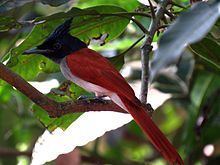Kingdom Animalia Family Monarchidae Genus Paradise flycatcher Order Passerine | Class Aves Phylum Chordata Rank Subspecies | |
 | ||
Similar Paradise flycatcher, Passerine, Indian paradise flycatcher, Jerdon's bush lark, White‑bellied drongo | ||
The Ceylon paradise flycatcher (Terpsiphone paradisi ceylonensis), also known as the Sri Lanka paradise flycatcher is a subspecies of the Indian paradise flycatcher. It is a resident subspecies and remains in Sri Lanka throughout the year, its typical habitat being the understory of dry lowland forest. It also occurs in gardens and dry hilly areas, and moves to other parts of the island outside the breeding season. The birds have black heads and chestnut upper parts, and the male has a black crest, and a much longer tail than the female.
Contents
The Ceylon paradise flycatcher flits about in the lower parts of woodland, feeding on insects which it catches in flight. It breeds between April and July, the cup-shaped nest being built of fine grasses and rootlets, bound together with spider's web, a few metres off the ground. Two or three reddish-brown speckled eggs are laid.
Taxonomy
The Ceylon paradise flycatcher is the resident subspecies out of the two subspecies of Indian paradise flycatcher found in Sri Lanka. The taxon was described by Nikolai Alekseyvich Zarudny & Hermann Härms in 1912.
Description
Adults are about 20 cm long. Shows sexual dimorphism. Adult male has a glossy black head with a black crest. The back, wings and the tail feathers are rufous in colour. Adult male is distinguished by the long tail feathers that are longer than the body. The tail is about 30 cm long. The female also has a black head. They are rufous on the back, wings and tail with a greyish throat and underparts. They have short tails. Immature males look very much like females.
The call, uttered often is a harsh tchree, and the song, uttered occasionally, is a musical twee-tee-twee-tyu.
Distribution and habitat
The Ceylon paradise flycatcher is found in Sri Lanka as a resident species. It flits about in wooded habitats and gardens. Mostly seen in the low country dry zone during the breeding season. Also seen in the dry lower hills. It visits other areas in the migrant season (northern winter).
Ecology and behaviour
Visits woods and flits about branches of small trees and bushes below the level of the taller trees in search of food during the daytime. Often flashes its tail as it actively takes insects on the wing. It habitually jump into a small puddle and take a bath in the evening.
Feeding
The Ceylon paradise flycatcher is insectivorous. It catches insects while in flight in the understory.
Breeding
Breeding season is from April to July. They breed in the dry lowlands and the lower hills. Build nests on a tree about 2–4 m or higher from the ground. The nest is made up of small grass, fibers connected by spider's web threads in the shape of a cup. They lay clutches of 2-3 eggs. The eggs are reddish brown with spots (More spots on the obtuse side).
